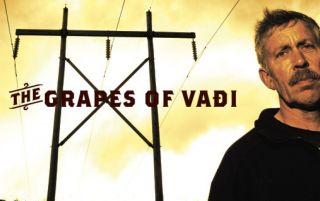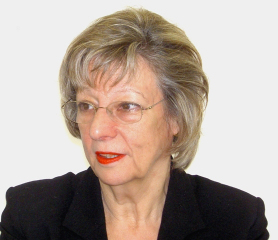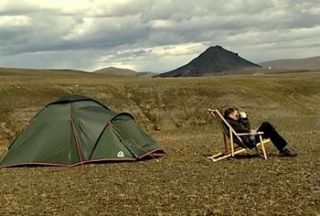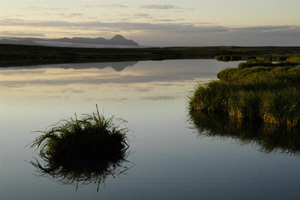Author Archive
Jul 19 2005
Actions, ALCOA, Impregilo, Kárahnjúkar, Landsvirkjun, Mark Kennedy, Saving Iceland
On Tuesday 19th July 2005 a group of approximately 20 of us hiked to the main junction approaching the site. Four of our group locked on to a pick up truck and a HUGE caterpillar construction vehicle. We managed to block two other access roads and halt work on the site for three hours.
This was a first in Icelandic history: the police had to make up a word for “lock-on”. Thirteen of us were “detained, apparently “arrested”, and later released without charge….with the warning that Impregilo were “looking at this incident with grave eyes” and were likely to make a civil case. Impregilo have since changed their mind. For a change, the media did report that the protesters were “friendly”!
Jun 24 2005
Actions, ALCOA, Bechtel, Impregilo, Kárahnjúkar, Landsvirkjun, Saving Iceland

The camp is east of Jökulsá á Brú, just before the bridge, 2 km. south of Kárahnjúkar. It is easily accessible by normal cars, about one and half hours drive from Egilsstaðir. Most of the road is asphalted but soon before you arrive at the camp it turns into a dust road and winds in sharp bends down towards the river. The camp is at the second bend towards the bridge.
Read More
Jun 20 2005
Actions, ALCOA, Bechtel, Century Aluminum, Climate Change, Corruption, Democracy deficit, Ecology, Greenwash, Impregilo, Kárahnjúkar, Landsvirkjun, Laws, Media bias, Ólafur Páll Sigurdsson, Pollution, R & D Carbon, Repression, Rio Tinto Alcan, Saving Iceland
Answers to common questions about the ‘skyr action’ at Hotel Nordica 14 June, 2005.
Why this conference?
* It was a conference for aluminium and the related industry leaders from all over the world.
* They were here because they think Iceland is right for heavy industrial development. Ironically, this is down to its clean environmental record.
* The people gathered there were key decision makers, financiers and policy drivers behind the Karahnjukar project and other heavy industry developments across Iceland which we oppose.
* A session entitled “An Approach to Sustainability for a Greenfield Aluminium Smelter” started at 11:45 on the day. Hosted by Joe Wahba of Bechtel Corporation and T.M. Sigurdsson of Alcoa, the outrageous hypocrisy of the seminar was extremely provocative to those who truly aspire to the ecological value of sustainability. Read More
Jun 04 2005
ALCOA, Climate Change, Economics, Impregilo, Kárahnjúkar, Landsvirkjun, Laws, Pollution, Saving Iceland
Grapevine Issue 6, August 2004 with update Jan. 2006
In the 1930s, dust storms swept the southern plains of the United States. The “Black Blizzards,” as they were called, had come about because of overfarming, which had caused the topsoil to wear thin and become dust. Crops failed, and as the banks that held the mortgages realised they would not be getting returns on their interest, farmers were run off of their land. Their plight is immortalised in the songs of Woody Guthrie and John Steinbeck’s book “The Grapes of Wrath”, which went on to become a Hollywood film starring Henry Fonda as Steinbeck´s protagonist Tom Joad. Read More
Apr 21 2005
Actions, ALCOA, Landsvirkjun, Ólafur Páll Sigurdsson, Saving Iceland
Iceland is under attack and needs international support to stop Corporate Companies destroying their beautiful landscapes. This is under the guise of a “benefit” for the community, but has been opposed since it began. No -one wants this to happen and it can be stopped!
A group of individuals wishing to support this campaign are raising funds to visit Iceland and raise the profile of this campaign thru’ a sponsored firewalk (yes, walking over hot coals!) to take place early June in Scotland. Read More
Apr 19 2005
ALCOA, Barclays, Bechtel, Corruption, Democracy deficit, Ecology, Economics, Impregilo, Kárahnjúkar, Landsvirkjun, Laws, Media bias, Ólafur Páll Sigurdsson, Pollution, Repression, Rio Tinto Alcan, Þjórsá, Þjórsárver
The Icelandic government and media tried to hush this story up by not reporting it for months! When environmental activist Olafur Pall Sigurdsson was being interviewed on a chat programme on the State Radio about hypothetical questions of civil disobedience he seized the opportunity and read aloud the whole of Doughty’s EDM. The programme presenter was seriously reprimanded by her bosses for allowing this.
British MP Sue Doughty has tabled a Parliamentary motion calling on the British Government to use its diplomatic links with Iceland to persuade the Icelandic Government to terminate the building of a series of dams in the Icelandic Highlands.
Read More
Apr 17 2005
Actions, ALCOA, Bechtel, Century Aluminum, Corruption, Cultural, Democracy deficit, Ecology, Economics, Greenwash, Impregilo, Kárahnjúkar, Landsvirkjun, Laws, Media bias, Ólafur Páll Sigurdsson, Pollution, Repression, Saving Iceland, Workers Rights
The founder of Saving Iceland/NatureWatch, Olafur Pall Sigurðsson, interviewed here on Radio IndyMedia.org.
http://www.indymedia.org.uk/en/2005/04/309355.html
Apr 13 2005
ALCOA, Bechtel, Century Aluminum, Democracy deficit, Ecology, Greenwash, Impregilo, Kárahnjúkar, Landsvirkjun, Media bias, Ólafur Páll Sigurdsson, Pollution, Repression, Saving Iceland, WWF
CorporateWatch.org
Newsletter Issue 23 April/May 2005
In March 2004, the government of Iceland held a conference in the capital Reykjavik. It was a private conference, attended by representatives of the top multinational corporations, Rio Tinto, Alcoa and Alcan among them, and the population were not told about it in advance. Iceland, a government spokesman informed its people afterwards, was now open for business. Read More
Mar 05 2005
Ecology, Landsvirkjun, Laws, Pollution, Þjórsárver
Lowana Veal
The Thjorsarver wetlands in South Iceland have been saved from the ravages of a hydro-electric scheme, at least for the foreseeable future.
Thjorsarver is a wetlands area that became listed as a RAMSAR site in 1990, principally because it is home to the world’s largest breeding ground for pink-footed geese, 6-10,000 breeding pairs. But many other birds nest there too, such as the purple sandpiper, red-necked phalarope, dunlin, Arctic tern, Arctic skua, ptarmigan, golden and ringed plovers, snow bunting and long-tailed duck. Botanically, it is home to 167 species of vascular plants as well as mosses and lichens, some of them rare. The insect life is rich.
Paradoxically, the designation of RAMSAR and nature reserve status should mean that the area be left untouched – but those with vested interests appeared to disregard this point. Read More
Feb 26 2005
1 Comment
ALCOA, Climate Change, Democracy deficit, Ecology, Greenwash, Kárahnjúkar, Landsvirkjun, Laws, Pollution
The Kárahnjúkar Power Plant is the largest industrial development in Iceland’s history. Roughly 3% of the total area of Iceland, approx. 290,000 ha, will be impacted by the project, not including areas of secondary impacts, such as windblown dust, long-term erosion, downstream or coastal silt and soil deposits, alterations in groundwater characteristics in peripheral areas with resulting changes in vegetation and wildlife habitats. Read More



